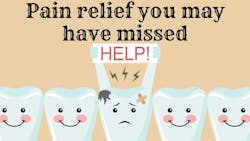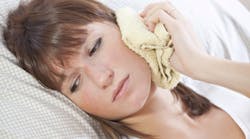Clinical tips: Pain management during hygiene procedures
Dental hygiene professionals provide their patients with valuable services that improve both their oral and systemic health. While most of these procedures are described as preventive, many patients experience varying degrees of pain or discomfort while receiving them.
Despite a clinician’s skill, instrument selection, or best intentions, sometimes there’s no getting around pain. This is especially true in situations involving gingival inflammation or exposed dentin. In recognizing this, RDHs need to come prepared with multiple options for chairside pain relief with every patient, for every procedure.
Topical anesthetics
Most dental professionals immediately think of benzocaine at the mention of topical anesthetic. It’s by far the most popular in the average general practice. But what many don’t know is that benzocaine is available in multidose syringe applicators for administration below the gumline. Onset typically happens within about two minutes of application and can last up to 60 minutes.1 May clinicians prefer the thick, viscous property of a 20% benzocaine gel that allows the active ingredient to remain localized in the intended area.
Another popular option for topical anesthesia is cetacaine, a combination of 14% benzocaine, 2% butamben, and 2% tetracaine.2 Although it has yet to be approved by the FDA, clinicians have enjoyed using this solution for years because of its ease of use in deep periodontal pockets before performing nonsurgical periodontal therapy (NSPT). Onset occurs within 15 to 30 seconds and provides up to 60 minutes of relief.3 The delivery system for this product also allows practitioners to use only what is needed, resulting in less waste.
Oraqix is also commonly used by hygienists looking for pain relief in deep periodontal pockets. Containing a eutectic mixture of 5% lidocaine and prilocaine, many hygienists feel that this solution serves as a reasonable alternative to local anesthesia in many NSPT procedures.4 The product is administered in a proprietary applicator, has an onset of 30 seconds, and lasts up to 20 minutes.
Some offices also use a variety of compounded anesthetic gels, pastes, and rinses. These products are specially formulated at a pharmacy and use a mixture of topical anesthetics in different strengths to provide differing degrees of soft tissue pain relief. Depending on the ingredients and their dosage, onset and duration can vary.
Local anesthesia
Many options are available for pain relief with injectable anesthetics. Depending on the extent of instrumentation, the severity of the disease, and the patient’s pain threshold, clinicians can choose between popular agents such as articaine, lidocaine, mepivacaine, or prilocaine. These agents can be accompanied by a vasoconstrictor—namely epinephrine—to isolate the anesthetic in the desired treatment area and extend its duration. Depending on a clinician’s state practice act, there may be restrictions regarding injection techniques.
Sound therapy
Research has been conducted the past several years regarding the way the brain responds to noise, whether it be music, white noise, or rhythmic patterns of sound. While sound therapy will not block pain receptors in the way that an anesthetic agent will, it can create signals that regulate the nervous system, thereby relaxing the patient and aiding in pain response.
A study conducted in 2021 showed that “slow rhythm melody music” without lyrics played during dental treatment resulted in decreased salivary cortisol, heart rate, body temperature, and blood pressure.5 This concept, especially when the patient wears headphones, could be a worthwhile accompaniment to anesthetic use to improve the patient experience.
References
1. Al-Samadani KH, Gazal G. Effectiveness of benzocaine in reducing deep cavity restoration and post-extraction stress in dental patients. Saudi Med J. 2015;36(11):1342-1347. doi:10.15537/smj.2015.11.12274
2. Cetacaine topical anesthetic. Daily Med. https://dailymed.nlm.nih.gov/dailymed/fda/fdaDrugXsl.cfm?setid=9777acbb-8166-4734-9932-dc66b05bfcb5&type=display
3. Cetacaine topical anesthetics. Cetylite. https://www.cetylite.com/dental/topical-anesthetics
4. Mayor-Subirana G, Yagüe-García J, Valmaseda-Castellón E, Arnabat-Domínguez J, Berini-Aytés L, Gay-Escoda C. Anesthetic efficacy of Oraqix versus Hurricaine and placebo for pain control during non-surgical periodontal treatment. Med Oral Patol Oral Cir Bucal. 2014;19(2):e192-e201. doi:10.4317/medoral.19202
5. Wazzan M, Estaitia M, Habrawi S, et al. The effect of music therapy in reducing dental anxiety and lowering physiological stressors. Acta Biomed. 2022;92(6):e2021393. doi:10.23750/abm.v92i6.11668
Bethany Montoya, BAS, RDH, is a practicing dental hygienist, editorial director of DentistryIQ's Clinical Insights newsletter and a key opinion leader. She has advanced knowledge and training in complex cosmetic dentistry, dental sleep medicine, and implant dentistry. Recently, she has devoted her time to dentistry’s personal and interpersonal aspects through her social media brand, @humanrdh. Contact Bethany at [email protected].
About the Author

Bethany Montoya, MBA, RDH
Bethany Montoya, MBA, RDH, is a practicing dental hygienist, educator, industry key opinion leader, and editorial director of DentistryIQ’s Clinical Insights newsletter. She has a passion for advancing modern disease prevention. She specializes in exploring the intersection of clinical practice, professional growth, and innovation within oral health care. Through her writing, she aims to educate, inspire, and spark meaningful dialogue in the dental community. She can be reached at [email protected].


